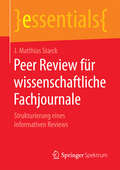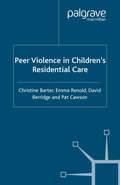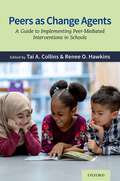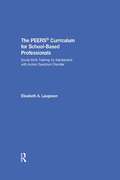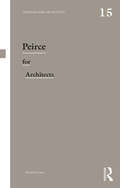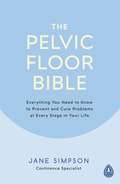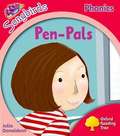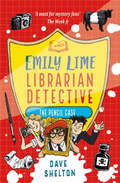- Table View
- List View
Peer Relationships in Early Childhood Education and Care
by Margaret KernanPeer Relationships in Early Childhood Education and Care brings together fresh perspectives and research about young children’s relationships. It examines children’s rights and well-being against a backdrop of increased social movement and migration, changing family structures and work practices, and the growing prevalence of education and care services for young children. With contributors from diverse cultural, geographical and disciplinary backgrounds, this edited collection shows how educators support children’s peer relationships and use these as a basis for enhancing social and cognitive development. Themes discussed include: conflicts and negotiations friendships and play group phenomena independence and interdependence identity and belonging peer relations and children with disabilities attuning adults to young children’s relationships. This book will be highly relevant for academics, researchers and students concerned with early childhood care and education, especially those interested in relating these issues on a global scale.
Peer Relationships in Early Childhood Education and Care
by Margaret Kernan Elly SingerPeer Relationships in Early Childhood Education and Care brings together fresh perspectives and research about young children’s relationships. It examines children’s rights and well-being against a backdrop of increased social movement and migration, changing family structures and work practices, and the growing prevalence of education and care services for young children. With contributors from diverse cultural, geographical and disciplinary backgrounds, this edited collection shows how educators support children’s peer relationships and use these as a basis for enhancing social and cognitive development. Themes discussed include: conflicts and negotiations friendships and play group phenomena independence and interdependence identity and belonging peer relations and children with disabilities attuning adults to young children’s relationships. This book will be highly relevant for academics, researchers and students concerned with early childhood care and education, especially those interested in relating these issues on a global scale.
Peer Review für wissenschaftliche Fachjournale: Strukturierung eines informativen Reviews (essentials)
by J. Matthias StarckJ. Matthias Starck führt den Leser in diesem essential durch alle Schritte des Schreibens eines Peer Reviews für eine wissenschaftliche Zeitschrift. Es baut auf einer prägnanten Analyse auf, wie Wissenschaft funktioniert, wie sie kommuniziert und wie sie veröffentlicht wird. Der Autor diskutiert verschiedene Peer-Review-Verfahren und deren mögliche Alternativen, ethische Leitlinien ebenso wie die ,dunklen Seitenʻ des wissenschaftlichen Publizierens. Damit hilft dieses essential dem Leser, im bestehenden System erfolgreich zu arbeiten sowie zu seiner weiteren Entwicklung und Verbesserung beizutragen.
Peer review in an Era of Evaluation: Understanding the Practice of Gatekeeping in Academia
by Eva Forsberg Lars Geschwind Sara Levander Wieland WermkeThis open access volume explores peer review in the scientific community and academia. While peer review is as old as modern science itself, recent changes in the evaluation culture of higher education systems have increased the use of peer review, and its purposes, forms and functions have become more diversified. This book put together a comprehensive set of conceptual and empirical contributions on various peer review practices with relevance for the scientific community and higher education institutions worldwide. Consisting of three parts, the editors and contributors examine the history, problems and developments of peer review, as well as the specificities of various peer review practices. In doing so, this book gives an overview on and examine peer review , and asks how it can move forward.This is an open access book.
Peer Review of Learning and Teaching in Higher Education: International Perspectives (Professional Learning and Development in Schools and Higher Education #9)
by Judyth Sachs Mitch ParsellIncorporating both theoretical and practical perspectives, this volume of papers explores varied aspects of peer review of teaching in higher education. The section on theory features contributions from academics based in Europe, North America and Australia. It provides a number of models demonstrating ways in which collegial peer commentary can enhance the quality of learning and teaching. The chapters examine in detail the importance of communication and leadership, and deploy evidence from one-on-one interviews that evince the value of considering collegiality, emotions, attitudes, and spaces in peer review. The analysis shows how these factors are central to the ways in which lecturers and teachers communicate with each other to create constructive opportunities for learning.The chapters on practical considerations detail the peer review process and include case studies from institutions in Africa, Europe, North America and Australia, which focus on different areas of the topic, including peer review as a quality assurance mechanism, peer review in distance education, peer review in foundation courses, and peer review embedded within a department and across a university. The book ends with an international perspective on the role of peer review in ensuring a holistic approach to quality enhancement in learning and teaching.
Peer Supervision in Coaching and Mentoring: A Versatile Guide for Reflective Practice
by Tammy Turner Michelle Lucas Carol WhitakerSupervision is increasingly required for a coach’s and a mentor's professional development, and engaging in reflective practice with peers can be a valuable way of meeting these needs. Peer supervision brings unique challenges though, including the possibility of collusion or stagnating at a shared developmental level. This book is written by practicing professional supervisors who engage in peer supervision themselves and train communities of coaches and mentors. It guides practitioners to develop and integrate their range of individual and group reflective practice activities alongside professional supervision. It draws upon essential theory and methodology, explores challenges and ethical dilemmas faced within peer supervision, and provides concrete guidance, useful techniques and helpful templates. This practical guide will be vital reading for individual coaching and mentoring practitioners and peer learning groups including within communities, universities and/or training programs. It will also support professional supervisors and organizations developing coaching cultures.
Peer Supervision in Coaching and Mentoring: A Versatile Guide for Reflective Practice
by Tammy Turner Michelle Lucas Carol WhitakerSupervision is increasingly required for a coach’s and a mentor's professional development, and engaging in reflective practice with peers can be a valuable way of meeting these needs. Peer supervision brings unique challenges though, including the possibility of collusion or stagnating at a shared developmental level. This book is written by practicing professional supervisors who engage in peer supervision themselves and train communities of coaches and mentors. It guides practitioners to develop and integrate their range of individual and group reflective practice activities alongside professional supervision. It draws upon essential theory and methodology, explores challenges and ethical dilemmas faced within peer supervision, and provides concrete guidance, useful techniques and helpful templates. This practical guide will be vital reading for individual coaching and mentoring practitioners and peer learning groups including within communities, universities and/or training programs. It will also support professional supervisors and organizations developing coaching cultures.
Peer Support in Action: From Bystanding to Standing By
by Helen Cowie Patti Wallace`It would be of use to adults and teachers who are starting to research peer support and the logistics of adopting such a scheme in their school. It would also be of use to saff who are currently operating a peer support scheme. I personally will use this book and keep a copy in the counselling service library, recommending it to counsellors/trainers and teachers interested or already facilitating peer support in their schools′ - British Journal of Guidance and Counselling `It is to read, comprehensive in its structure and advice and through examples of first-hand experiences, makes the reader feel enthusiastic about trying out different ideas…. An excellent handbook for the manager of a peer support system for any organization′ - Anne Woodhouse, Clinical Child Psychology and Psychiatry Peer support systems are increasingly being used in schools and other youth settings to tackle problems such as bullying, rejection, social exclusion, sexual identity, self-esteem and loneliness. Peer Support in Action is a practical guide which gives adults who work with children and young people the knowledge, understanding and practical tools to provide effective and appropriate systems of peer support. Helen Cowie and Patti Wallace combine insights drawn from practice with up-to-date research findings, to give a sound basis for peer-based interventions. They encourage readers to build on the potential for offering help which many young people have and give practical guidance on how to train, guide and supervise them in supporting their peers. Peer Support in Action is for teachers, educational psychologists, social workers, education welfare officers, counsellors and counselling psychologists and all professionals involved in the pastoral care and guidance of children and young people.
Peer Support in Action: From Bystanding to Standing By
by Helen Cowie Patti Wallace`It would be of use to adults and teachers who are starting to research peer support and the logistics of adopting such a scheme in their school. It would also be of use to saff who are currently operating a peer support scheme. I personally will use this book and keep a copy in the counselling service library, recommending it to counsellors/trainers and teachers interested or already facilitating peer support in their schools′ - British Journal of Guidance and Counselling `It is to read, comprehensive in its structure and advice and through examples of first-hand experiences, makes the reader feel enthusiastic about trying out different ideas…. An excellent handbook for the manager of a peer support system for any organization′ - Anne Woodhouse, Clinical Child Psychology and Psychiatry Peer support systems are increasingly being used in schools and other youth settings to tackle problems such as bullying, rejection, social exclusion, sexual identity, self-esteem and loneliness. Peer Support in Action is a practical guide which gives adults who work with children and young people the knowledge, understanding and practical tools to provide effective and appropriate systems of peer support. Helen Cowie and Patti Wallace combine insights drawn from practice with up-to-date research findings, to give a sound basis for peer-based interventions. They encourage readers to build on the potential for offering help which many young people have and give practical guidance on how to train, guide and supervise them in supporting their peers. Peer Support in Action is for teachers, educational psychologists, social workers, education welfare officers, counsellors and counselling psychologists and all professionals involved in the pastoral care and guidance of children and young people.
Peer Support in the Primary Playground
by Linda BellThis book is an essential resource to develop playground relationships. Increasingly schools are working very closely with their children, helping them to develop the skills needed to take charge of their own actions and encourage responsible attitudes towards others in the school. The programme for children outlined in this book, 'Playground Champions', is a primary playground peer support initiative which: trains older children to support their peers in solving issues within the playground by focusing on rebuilding relationships rather than apportioning blame; encourages children to see the viewpoint of others and to create their own mutually agreeable solutions; and, helps to establish emotional health and well-being, safety and happiness. The programme is structured, easy to follow and can be used by teachers and teaching assistants within the school. These printable training materials and resources are comprehensive and can be readily adapted to suit the needs of individual children and schools. The programme fits into the current national initiatives such as Every Child Matters, Social and Emotional Aspects of Learning (SEAL), Citizenship and National Healthy Schools and demonstrates good practice for the annual school self-evaluation form (SEF) and Ofsted. It can also add to the evidence required for the school's disability equality scheme showing that they are committed to disability equality and eliminating bullying and harassment. When properly implemented it will help to develop confidence and improve self-esteem in pupils as well as improving behaviour and reducing stress, leading to a happier and healthier school environment. It is suitable for age: 4-11.
Peer Support in the Primary Playground
by Linda BellThis book is an essential resource to develop playground relationships. Increasingly schools are working very closely with their children, helping them to develop the skills needed to take charge of their own actions and encourage responsible attitudes towards others in the school. The programme for children outlined in this book, 'Playground Champions', is a primary playground peer support initiative which: trains older children to support their peers in solving issues within the playground by focusing on rebuilding relationships rather than apportioning blame; encourages children to see the viewpoint of others and to create their own mutually agreeable solutions; and, helps to establish emotional health and well-being, safety and happiness. The programme is structured, easy to follow and can be used by teachers and teaching assistants within the school. These printable training materials and resources are comprehensive and can be readily adapted to suit the needs of individual children and schools. The programme fits into the current national initiatives such as Every Child Matters, Social and Emotional Aspects of Learning (SEAL), Citizenship and National Healthy Schools and demonstrates good practice for the annual school self-evaluation form (SEF) and Ofsted. It can also add to the evidence required for the school's disability equality scheme showing that they are committed to disability equality and eliminating bullying and harassment. When properly implemented it will help to develop confidence and improve self-esteem in pupils as well as improving behaviour and reducing stress, leading to a happier and healthier school environment. It is suitable for age: 4-11.
Peer Support Services Reaching People with Schizophrenia: Considerations for Research and Practice
by Megan EvansMany mental health providers are seeking guidance in designing and improving peer support programs for people with mental illnesses. However, the evidence base in this area is limited by lack of consensus on the core components of peer support. This research provides a comprehensive, nuanced view of peer support reaching people with schizophrenia. Results of a realist review of 355 sources and interviews with experts in the field are presented. Realist review is an approach to evidence synthesis that asks, ‘What works, for whom, and in what circumstances?’ Results include a typology of key functions of peer support (e.g., being there, linkage to clinical care and community resources, systems advocacy, ongoing support), documented benefits (e.g., decreased acute care utilization, increased recovery), and implementation recommendations (e.g., critical mass of peer workers, supportive infrastructure, an organizational recovery orientation). The book is intended for program planners, managers, and researchers.
Peer Violence in Children's Residential Care
by C. Barter E. Renold D. Berridge P. CawsonMuch concern has been expressed about the scandal of physical and sexual abuse by care workers of children living in residential homes but this is the first detailed study of the major problem of violence between children . Based on extensive interviews with young people as well as staff, children's own perspectives and experiences of violence are highlighted. There is important new information about different levels of violence between homes, the significance of gender and group hierarchies, and strategies to tackle violence.
Peers as Change Agents: A Guide to Implementing Peer-Mediated Interventions in Schools
by Taia. Collins, Renee O. HawkinsIn schools, much of the responsibility of implementing interventions to improve outcomes for students falls on teachers, which may lead to capacity and resource issues. One solution to this problem is the use of Peer-Mediated Interventions (PMIs), which include a variety of approaches that utilize similar individuals to the target student (e.g., students in school-based interventions) as interventionists or behavior change agents. Although there is a wealth of research to support the effectiveness of students as interventionists, peers remain an under-utilized resource in school-based intervention delivery. Peers as Change Agents is a comprehensive resource for school-based professionals working to incorporate PMIs across academic, behavioral, and social-emotional interventions. The text synthesizes the current research on school-based PMIs and distills the literature into concrete strategies that can be easily implemented in school-based contexts. Building on the foundational principles of PMIs, the authors reconceptualize this work into three new categories: Peer-Mediated Academic Interventions; Peer-Mediated Behavioral Interventions; and Peer-Mediated Group Supports, to better address students' unique needs. Chapters also highlight the advantages of PMIs, including their potential for cultural relevance. As school staff continue to grapple with the practical challenges of ensuring equity in student outcomes, Peers as Change Agents provides educators, school psychologists, and counsellors effective and efficient tools to support students as change agents in their own learning communities.
Peers as Change Agents: A Guide to Implementing Peer-Mediated Interventions in Schools
In schools, much of the responsibility of implementing interventions to improve outcomes for students falls on teachers, which may lead to capacity and resource issues. One solution to this problem is the use of Peer-Mediated Interventions (PMIs), which include a variety of approaches that utilize similar individuals to the target student (e.g., students in school-based interventions) as interventionists or behavior change agents. Although there is a wealth of research to support the effectiveness of students as interventionists, peers remain an under-utilized resource in school-based intervention delivery. Peers as Change Agents is a comprehensive resource for school-based professionals working to incorporate PMIs across academic, behavioral, and social-emotional interventions. The text synthesizes the current research on school-based PMIs and distills the literature into concrete strategies that can be easily implemented in school-based contexts. Building on the foundational principles of PMIs, the authors reconceptualize this work into three new categories: Peer-Mediated Academic Interventions; Peer-Mediated Behavioral Interventions; and Peer-Mediated Group Supports, to better address students' unique needs. Chapters also highlight the advantages of PMIs, including their potential for cultural relevance. As school staff continue to grapple with the practical challenges of ensuring equity in student outcomes, Peers as Change Agents provides educators, school psychologists, and counsellors effective and efficient tools to support students as change agents in their own learning communities.
The PEERS® Curriculum for School Based Professionals: Social Skills Training for Adolescents With Autism Spectrum Disorder
by Elizabeth A. LaugesonThe PEERS® Curriculum for School-Based Professionals brings UCLA's highly acclaimed and widely popular PEERS program into the school setting. This sixteen-week program, clinically proven to significantly improve social skills and social interactions among teens with autism spectrum disorder, is now customized for the needs of psychologists, counselors, speech pathologists, administrators, and teachers. The manual is broken down into clearly divided lesson plans, each of which have concrete rules and steps, corresponding homework assignments, plans for review, and unique, fun activities to ensure that teens are comfortable incorporating what they've learned. The curriculum also includes parent handouts, tips for preparing for each lesson, strategies for overcoming potential pitfalls, and the research underlying this transformative program.
The PEERS® Curriculum for School Based Professionals: Social Skills Training for Adolescents With Autism Spectrum Disorder
by Elizabeth A. LaugesonThe PEERS® Curriculum for School-Based Professionals brings UCLA's highly acclaimed and widely popular PEERS program into the school setting. This sixteen-week program, clinically proven to significantly improve social skills and social interactions among teens with autism spectrum disorder, is now customized for the needs of psychologists, counselors, speech pathologists, administrators, and teachers. The manual is broken down into clearly divided lesson plans, each of which have concrete rules and steps, corresponding homework assignments, plans for review, and unique, fun activities to ensure that teens are comfortable incorporating what they've learned. The curriculum also includes parent handouts, tips for preparing for each lesson, strategies for overcoming potential pitfalls, and the research underlying this transformative program.
Peirce for Architects (Thinkers for Architects)
by Richard CoyneIdeas gain legitimacy as they are put to some practical use. A study of Charles Sanders Peirce (1839-1914) supports this pragmatism as a way of thinking about truth and meaning. Architecture has a strong pragmatic strand, not least as we think of building users, architecture as a practice, the practical demands of building, and utility. After all, Vitruvius placed firmness and delight in the company of utilitas amongst his demands on architecture. Peirce (pronounced 'purse') was a logician, and so many of his ideas are couched in terms of formal propositions and their limitations. His work appeals therefore to many architects grappling with the digital age, and references to his work cropped up in the Design Methods Movement that developed and grew from the 1950s. That movement sought to systematise the design process, contributing to the idea of the RIBA Plan of Work, computer-aided design, and various controversies about rendering the design process transparent and open to scrutiny. Peirce’s commitment to logic led him to investigate the basic elements of logical statements, notably the element of the sign. His best-known contribution to design revolves around his intricate theory of semiotics, the science of signs. The study of semiotics divided around the 1980s between advocates of Peirce’s semiotics, and the broader, more politically charged field of structuralism. The latter has held sway in architectural discourse since the 1980s. Why this happened and what we gain by reviving a Peircean semiotics is the task of this book.
Peirce for Architects (Thinkers for Architects)
by Richard CoyneIdeas gain legitimacy as they are put to some practical use. A study of Charles Sanders Peirce (1839-1914) supports this pragmatism as a way of thinking about truth and meaning. Architecture has a strong pragmatic strand, not least as we think of building users, architecture as a practice, the practical demands of building, and utility. After all, Vitruvius placed firmness and delight in the company of utilitas amongst his demands on architecture. Peirce (pronounced 'purse') was a logician, and so many of his ideas are couched in terms of formal propositions and their limitations. His work appeals therefore to many architects grappling with the digital age, and references to his work cropped up in the Design Methods Movement that developed and grew from the 1950s. That movement sought to systematise the design process, contributing to the idea of the RIBA Plan of Work, computer-aided design, and various controversies about rendering the design process transparent and open to scrutiny. Peirce’s commitment to logic led him to investigate the basic elements of logical statements, notably the element of the sign. His best-known contribution to design revolves around his intricate theory of semiotics, the science of signs. The study of semiotics divided around the 1980s between advocates of Peirce’s semiotics, and the broader, more politically charged field of structuralism. The latter has held sway in architectural discourse since the 1980s. Why this happened and what we gain by reviving a Peircean semiotics is the task of this book.
Pelican Guided Reading and Writing, Reader 13, Year 3: Characters All at Sea! (PDF)
by Jeremy Strong Wendy BodyShort stories on the theme of people in trouble at sea, from shipwrecks to pirates.
Pelican Guided Reading and Writing, Reader 13, Year 3: Characters All at Sea! (PDF)
by Jeremy Strong Wendy BodyShort stories on the theme of people in trouble at sea, from shipwrecks to pirates.
The Pelvic Floor Bible: Everything You Need to Know to Prevent and Cure Problems at Every Stage in Your Life
by Jane SimpsonHave you ever laughed so much you wet yourself - just a little bit? Or found yourself crossing your legs on the doorstep frantically searching for your keys? Do you get up at night to go to the toilet more than once?An estimated 200 million people around the world suffer from some form of urinary incontinence. It's an embarrassing problem that affects women disproportionately as a result of pregnancy and childbirth. In The Pelvic Floor Bible, Jane Simpson argues that it's time for us all to feel the squeeze and celebrate the wonder of our pelvic floor muscles. She shows you how to incorporate pelvic floor exercises as part of your daily routine in order to prevent issues in later life and cure existing problems now. Learn how to treat common problems such as stress incontinence, overactive bladder and prolapse, get back into shape post-pregnancy and enjoy a healthy sex life at every stage of your life. Incontinence is both preventable and curable through pelvic floor exercises and rehabilitation but too many people assume nothing can be done, follow incorrect advice or are ashamed to seek help. We need to end the taboo now.
Pen and Wash: An artist's guide to combining ink and watercolour
by John HarrisonPen and Wash is a practical guide to creating a picture that captures the discipline of pen, along with the subtlety of watercolour. With clear instruction and inspirational examples throughout, it explains the conventional approach of drawing and then adding wash, but also explores alternative ideas and styles. The author's passion for the technique is evident in his examples and enthusiastic text, making the book a superb guide to this beautiful medium. Advise on the correct equipment, techniques, the unpredictable nature of watercolours and Step by step demonstrations of pen and wash techniques.
Pen-Pals (ORT, Stage 4, More Songbirds, Phonics) (PDF)
by Julia DonaldsonIn Pen-Pals, Joan from America comes to visit Megan.
The Pencil Case (Emily Lime: Librarian Detective)
by Dave SheltonIt's a new term at St Rita's School for Spirited Girls, and there are new mysteries for Emily, Daphne and George to solve!Who has stolen a painting from Pilkington Art Gallery? (And why? It's not even a very good one!)How can they get rid of a new headmistress who theatens the very future of the library?And why are there cows all over the sports field?Expect the unexpected as Emily Lime investigates!

